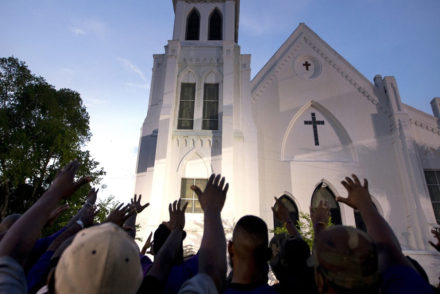This is the final installment in a five-part blog series on how to think carefully and faithfully about what the Bible teaches about the end of the world. To read part 4 of this series, click HERE.
Here we are at the end of our series on talking about the end of the world and at the beginning of the season of Advent, when God’s people meditate upon the mercy and grace the Father showed the whole world by sending the Son into the world to dwell with us, to die for us, and to rise from the dead to conquer sin and death for us. It is wholly appropriate for us to consider the two advents together, because, while the two should never be confused, the Scripture speaks about both together and often in very similar ways.
Think about what the angel proclaimed to Mary in Luke’s Gospel:
He will be great and will be called the Son of the Most High. And the Lord God will give to him the throne of his father David, and he will reign over the house of Jacob forever, and of his kingdom there will be no end.
There is a very real sense in which the kingdom of God arrived with Jesus. He inaugurated it by his life, death, and resurrection. Jesus reigns on the throne of David forever, and his kingdom is unending.
Jesus consistently spoke as if the kingdom of God was here. For example, in Luke 17 Jesus proclaims:
The kingdom of God is not coming in ways that can be observed, nor will they say, ‘Look, here it is!’ or ‘There!’ for behold, the kingdom of God is in the midst of you.
Paul also consistently spoke as if the kingdom of God was here. Paul’s message to the gentiles was that Jesus is Lord! Jesus, the savior of the whole world, has come, therefore we should repent and follow Jesus. Paul and Luke both call this message “the preaching of the gospel of the kingdom” and speak as though we are living in God’s kingdom now (e.g. Acts 20:25, Romans 14:17).
And yet the New Testament makes clear that the kingdom of God is still future. The coming of God’s kingdom is a central piece of the eschatological puzzle. In Revelation 11 there is a symbolic depiction of the second advent of Christ with the blowing of the seventh trumpet. When that trumpet is blown, all of heaven cries out:
The kingdom of the world has become the kingdom of our Lord and of his Christ, and he shall reign forever and ever.
The kingdom comes upon the earth with Christ when he returns in glory, and yet, even when heaven declares the coming of the kingdom, it can’t help but use the same language that was used at Christ’s first coming.
So which is it? Is the kingdom here already? Or is the kingdom not yet here?
The answer is “Yes!”
The already and the not yet aspects of the Advents of Christ are taught throughout Scripture. Take our salvation as an example. If you were to sit down with the Apostle Paul and ask him directly about when we are saved, you might ask it this way: “Paul, was I saved before the foundation of the world? Was I saved when Christ died on the cross for the sins of the world? Was I saved when I placed my faith in Christ as savior? Or will I be saved when Christ returns?” Paul would almost certainly answer, “Yes!” Am I saved now? Yes! Am I saved like I’m going to be saved when Christ returns to rescue me from even the very presence of sin into his glorious kingdom? No!
The same is true for Christ’s comings. Is Christ’s kingdom here? Yes! Christ made the kingdom of God a reality right now. We who follow Christ live as members of that kingdom right now. But the kingdom of God is not here like it is going to be here when Christ returns to bring the fulfillment of the kingdom with him. Only then will God’s will truly be done on earth as it is in heaven. Then peace and righteousness will reign, not just in the hearts of Christ’s people, but in all the universe. Peace and righteousness will reign because Jesus, the prince of peace and the righteousness, will dwell with his people.
It can be a bit tricky to try to understand the kingdom of God as already and not yet. Jesus called this aspect of the kingdom a mystery and spoke about it frequently in his parables. If you are intrigued by how Jesus taught about the kingdom in his parables, keep watching ChurchandGospel.com. All throughout 2019 I will be running a blog series about the parables of Jesus, and we will spend some time focusing on the parables of the kingdom.
As I suggested at the beginning, it is not at all inappropriate to talk about the second coming of Jesus during the Advent season. There is a long and faithful Christian tradition of talking about them together, because that’s how the Scripture so often discusses them. So, I will end this blog and this year by quoting a great Christmas carol that, whether it intends to or not, understands the relationship between the first and second comings of Jesus, between the already and the not yet of Christ’s kingdom.
Joy to the world, the Lord is come!
Let earth receive her King;
Let every heart prepare Him room,
And Heaven and nature sing.
Joy to the World, the Savior reigns!
Let men their songs employ;
While fields and floods, rocks, hills and plains
Repeat the sounding joy.
No more let sins and sorrows grow,
Nor thorns infest the ground;
He comes to make His blessings flow
Far as the curse is found.
He rules the world with truth and grace,
And makes the nations prove
The glories of His righteousness,
And wonders of His love.
Merry Christmas and Happy New Year!




